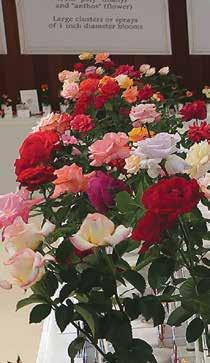Hydrangea Care Calendar: Part 2 Introduction by Natalie Carmolli, Proven Winners® ColorChoice®
F
ollowing up on last month’s article, it’s the second half of the hydrangea care calendar! As with most shrubs, midsummer care is pretty easy, but we’ll start with watering notes. Sometimes in midsummer, you’ll notice your hydrangea wilting. To determine the cause, think about conditions and how often you water them. Is it watered by hand or with a sprinkler system? Has it been hot and dry, or has there been good rainfall? While hydrangeas perform best with regular water, they can suffer in situations where the soil stays wet for long periods, how much water it has been getting is key. Drooping foliage on overwatered plants tends to feel soft and flabby. It may look dark brown or even black. Often the flowers wilt dramatically as well. If the plant is being overwatered/has poor drainage, water less frequently, or adjust irrigation heads to deliver less water. If the plant is getting too little water, drooping leaves often feel dry and crispy, and take on a dusty look. Unless the lack of water is extreme, the flowers usually won’t wilt when the plant is under-watered. Extra, deep watering during hot periods should be sufficient. A 2-3” layer of shredded bark mulch will keep roots cool and conserve moisture. Hydrangea Care July-December July – bloom time! Earlyblooming panicle hydrangeas, like Little Quick Fire®, usually start around July 4, and the rest usually get started a week or so later, depending on the climate. While it is tempting to cut fresh hydrangea flowers to enjoy in a vase, they often wilt if cut too fresh. It’s best to wait until the florets feel slightly
Above: Hydrangea paniculata Little Quick Fire Below: Hydrangea blooms from the garden liven any room indoors.
dry and papery before beginning to cut. You may deadhead spent flowers on bigleaf hydrangeas if you wish – follow the stem back to the first set of buds below the spent bloom and cut just above them. This isn’t strictly necessary, it’s a matter of personal preference. Because smooth and panicle hydrangeas develop interesting
STACEY HIRVELA Horticulturist 12
June 2022 | kcgmag.com
color that persists into fall, do not deadhead these types unless the blooms go brown, which indicates heat/drought stress. Stop fertilizing no later than late July – fertilizing past this time can push soft growth that can be damaged by cold weather in a few months. Water as needed. Note that bigleaf hydrangea flowers will of-
ten flag in the heat of the day, then spring back in the cool evening. But if it’s too extreme, make a note to move it the following spring to a more favorable spot. August – time to cut hydrangea flowers for drying. Whatever color they have when you cut them is the color they will stay when they are dry, so if you want, say, ‘Limelight’ or Quick Fire Fab® with their characteristic pink colors, wait until that develops before cutting. Water as needed – any drought stress will shorten bloom time. September – flowers can still be cut, if desired. October – your hydrangea is likely going dormant and needs little attention. If it developed leaf spots over the season, remove and discard the fallen foliage to minimize the chance of reinfection for next year. Top-up mulch to maintain a 2-3” layer for winter protection. As your plant goes dormant, resist the urge to cut it back or prune it. Doing so could remove all of the flower buds for the following season on some hydrangeas. When in doubt, don’t prune! November – hydrangeas should be going completely dormant. I generally recommend spring pruning, but it is permissible to follow the March pruning instructions if you prefer, or if you won’t be around in March to prune then. December-February – your hydrangea is dormant and resting up for another great season. If you see any snow or ice damage to the plants overwinter, don’t panic – you can fix it with spring pruning. Note: in warmer climates (USDA zones 7-9), the March-July timeline may be shifted up by as much as 6-8 weeks compared to what’s laid out here, which is what you’d expect in USDA zones 3-6. And that’s it! No matter the hydrangea, once you establish a care calendar that works, these floriferous plants will give you months of beautiful blooms.
A graduate of the School of Professional Horticulture at the New York Botanical Garden, Stacey Hirvela currently works as the marketing manager for Proven Winners® Color Choice® shrubs.













